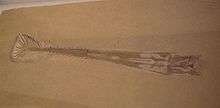1833 in paleontology
| |||
|---|---|---|---|
|
Paleontology or palaeontology (from Greek: paleo, "ancient"; ontos, "being"; and logos, "knowledge") is the study of prehistoric life forms on Earth through the examination of plant and animal fossils.[1] This includes the study of body fossils, tracks (ichnites), burrows, cast-off parts, fossilised feces (coprolites), palynomorphs and chemical residues. Because humans have encountered fossils for millennia, paleontology has a long history both before and after becoming formalized as a science. This article records significant discoveries and events related to paleontology that occurred or were published in the year 1833.
Dinosaurs
Newly named dinosaurs
| Taxon | Novelty | Status | Author(s) | Age | Unit | Location | Notes | Images |
|---|---|---|---|---|---|---|---|---|
|
Gen. nov. |
Probably a teleosaurid crocodyliform in addition to being "forgotten."[3] |
|||||||
|
Gen. et sp. nov. |
Valid |
Early Cretaceous, 140–136 million years ago[5] |
Tilgate Forest, Grinstead Clay Formation,[5] Westfalen[6] |
Hylaeosaurus was named in 1833 by Mantell for most of a skeleton including a isolated tail. This material was then later described in more detail by Mantell and Alexander Gordon Melville in a 1849 publication entitled Additional Observations on the Osteology of the Iguanodon and Hylaeosaurus.[7] |
| |||
Pterosaurs
New taxa
| Name | Novelty | Status | Author(s) | Age | Unit | Location | Notes | Images |
|---|---|---|---|---|---|---|---|---|
|
Gen. et sp. nov. |
Valid |
Late Jurassic, 155–150 million years ago |
A gnathosaurine ctenochasmatid. This is one of two species assigned to Gnathosaurus, the other being G. macrurus. Aurorazhdarcho is a potential junior synonym of Gnathosaurus subulatus.[9] Gnathosaurus as well as related genera such as Germanodactylus, Ctenochasma, and Pterodactylus all possessed large soft tissue crests. All four genera are from the Solnhofen Limestone, and share a common ancestor which, presumably, also had a crest.[8] |
| ||||
References
- ↑ Gini-Newman, Garfield; Graham, Elizabeth (2001). Echoes from the past: world history to the 16th century. Toronto: McGraw-Hill Ryerson Ltd. ISBN 9780070887398. OCLC 46769716.
- ↑ Geoffroy Saint-Hilaire, É-F. 1833. Considérations sur les ossements fossiles, la plupart inconnus, trouvés et observés dans les bassins d'Auvergne. Revue Encyclopédique (Paris) 59: pp. 76-95.
- ↑ Olshevsky, George. "Dinogeorge's Dinosaur Genera List". Retrieved 2008-08-07.
- ↑ Mantell, G.A. (1833). "Observations on the remains of the Iguanodon, and other fossil reptiles, of the strata of Tilgate Forest in Sussex". Proceedings of the Geological Society of London. 1: 410–411.
- 1 2 Naish, D.; Martill, D.M. (2008). Dinosaurs of Great Britain and the role of the Geological Society of London in their discovery: Ornithischia. Journal of the Geological Society. 165. London. pp. 613–623.
- ↑ Sachs, S.; Hornung, J. J. (2013). Evans, David C, ed. "Ankylosaur Remains from the Early Cretaceous (Valanginian) of Northwestern Germany". PLoS ONE. 8 (4): e60571. doi:10.1371/journal.pone.0060571.
- ↑ Mantell, G.A.; Melville, A.G. (1849). "Additional Observations on the Osteology of the Iguanodon and Hylaeosaurus". Philosophical Transactions of the Royal Society of London. 139: 271–305. doi:10.1098/rstl.1849.0015. JSTOR 108479.
- 1 2 Bennett, C.S. (2002). "Soft Tissue Preservation of the Cranial Crest of the Pterosaur Germanodactylus from Solnhofen". Journal of Vertebrate Paleontology. 22 (1): 43–48. doi:10.1671/0272-4634(2002)022[0043:STPOTC]2.0.CO;2. JSTOR 4524192.
- ↑ Bennett, C.S. (2013). "New information on body size and cranial display structures of Pterodactylus antiquus, with a revision of the genus". Paläontologische Zeitschrift. 87 (2): 269–289. doi:10.1007/s12542-012-0159-8.


